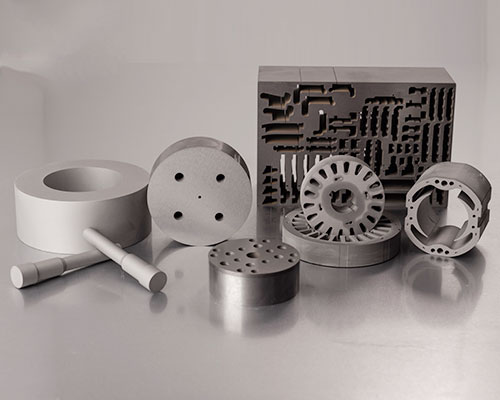
How to choose carbide circular saw blade?
The cemented carbide saw blade consists of several parameters, such as the type of the alloy head, the material of the matrix, the diameter, the number of teeth, the thickness, the shape of the teeth, the Angle, the aperture and so on. These parameters determine the machining capacity and cutting performance of the saw blade. When choosing saw blade, it is necessary to correctly select saw blade according to the type of sawing material, thickness, speed of sawing, direction of sawing, feeding speed and width of saw path
First, choose carbide saw blade according to the working environment
1. 65Mn spring steel good elasticity and plasticity, material economy, heat treatment hardenability is good, its heating temperature is low, easy deformation can be used for cutting requirements are not high saw blade. Tungsten steel alloy manufacturers
2 carbon tool steel with high carbon thermal conductivity, but by 200℃-250℃ temperature of its hardness and wear resistance sharply decreased, heat treatment deformation, poor hardenability, tempering time is long and easy to crack. Manufacturing economic materials for tools such as T8A, T10A, T12A, etc. Carbide saw blade
3. Compared with carbon tool steel, alloy tool steel has good heat resistance, wear resistance and processing performance. The heat resistance deformation temperature is between 300℃ and 400℃, which is suitable for manufacturing high-grade alloy circular saw blades.
4. High-speed tool steel has good hardenability, strong hardness and rigidity, less heat resistance and deformation, belongs to ultra-high strength steel, thermoplastic stability suitable for the manufacture of high-grade ultra-thin saw blades.
Two, workpiece size and carbide saw blade commonly used diameter selection
The diameter of carbide saw blade is related to the sawing equipment used and the thickness of the sawing workpiece. Saw blade diameter is small, cutting speed is relatively low; Saw blade diameter to the saw blade and sawing equipment requirements should be high, while sawing efficiency is also high. Saw blade outer diameter according to different circular saw machine models choose to use the saw blade with the same diameter. The diameters of standard parts are: 110MM(4 inches), 150MM(6 inches), 180MM(7 inches), 200MM(8 inches), 230MM(9 inches), 250MM(10 inches), 300MM(12 inches), 350MM(14 inches), 400MM(16 inches), 450MM(18 inches), 500MM(20 inches), etc., The bottom slot saw blade of precision cutting saw is mostly designed to be 120MM.

Three, according to the processing technology and the choice of hard alloy saw blade tooth shape commonly used tooth shape has left and right teeth (alternate teeth), flat teeth, ladder flat teeth (high and low teeth), inverted trapezoid teeth (inverted conical teeth), dovetail teeth (hump teeth), and rarely seen industrial grade three left and right, left and right flat teeth.
1. The left and right teeth are widely used, the cutting speed is fast, and the grinding is relatively simple. Suitable for cutting and cross-sawing all kinds of soft and hard wood profiles and density board, multilayer board, particleboard, etc. The left and right teeth equipped with anti-rebound protection teeth are dovetail teeth, suitable for longitudinally cutting a variety of boards with tree joints; The left and right teeth saw blades with negative front Angle are usually used for cutting panels because of their sharp serrated teeth and good cutting quality.
2. Flat tooth saw edge is rough, cutting speed is slow, grinding Z is simple. It is mainly used for sawing ordinary wood with low cost. It is mostly used for aluminum saw blades with small diameter to keep cutting and reduce adhesion, or for slotting saw blades to keep the groove bottom flat. 3. Ladder flat teeth are a combination of trapezoid teeth and flat teeth, grinding is more complex, sawing can reduce veneer cracking phenomenon, suitable for all kinds of single and double veneer wood-based board, fire-proof board sawing. In order to prevent adhesion, aluminum saw blades with more teeth are also used.
4. The reverse ladder teeth are often used in the bottom slot saw blade of the cutting saw. When cutting the wood-based panel with double veneer, the slot saw adjusts the thickness to complete the slotting processing of the bottom surface, and then the main saw completes the sawing processing of the plate to prevent the saw edge collapse phenomenon.
Four, according to the processing equipment and the choice of carbide saw blade aperture
Aperture is a relatively simple parameter, mainly according to the requirements of the equipment selection, but in order to maintain the stability of the saw blade, more than 250MM saw blade Z is best to choose the equipment with a larger aperture. At present, the aperture of the standard parts of the domestic design, 120MM and below the diameter of 20MM holes, 120-230MM for 25.4MM holes, more than 250 for 30 holes, some imported equipment also has 15.875MM holes, the aperture of the multi-piece saw machinery is relatively complex, more equipped with keyway to ensure stability. Regardless of the size of the aperture, it can be transformed by a lathe or a line cutting machine. The lathe can have a washer set in the large aperture, and the line cutting machine can reaming as required by the equipment. A series of parameters such as the type of alloy cutter head, material of matrix, diameter, number of teeth, thickness, shape of teeth, Angle, aperture, etc. are combined into the whole of hard alloy saw blade. Only reasonable selection and collocation can give full play to its advantages.